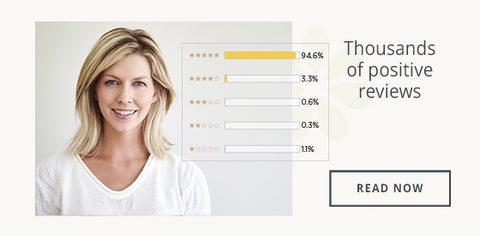Don’t Let Menopause Take Over Your Life!
Women transitioning into menopause experience a variety of symptoms, but there is a typical profile of what a menopausal woman looks like to the rest of the world. She is generally fair, fat, and flabby, always anxious and finding it difficult to relax. She struggles with frayed nerves because she just can’t get enough quality sleep. She keeps on forgetting things and is suddenly overwhelmed by the usual daily chores. That’s not to mention those dreaded hot flushes and panic attacks that leave her close to being incapacitated at certain times of the day.
Some people even compare this middle-aged woman to an infertile, dried-up prune who has lost interest in physical pleasure. Incontinence, depression and old age are knocking at her door, and it seems life is over for the typical menopausal woman going through this crucial phase in her life.
Menopause can be a new beginning
This paints a very negative picture which is not necessarily a true assumption of how the “change of life” progresses. Yes, many women feel these deep physical and emotional sensations; however, it does not need to be this way. The typical menopausal woman may have some complaints but largely, they don't have to stop her from leading a rich and fulfilling life as she connects to herself, her partner, her family and her community. She may be a loving grandmother caring for her grandchildren. She could be actively supporting a community group. She can start a new hobby, take a course that interests her, or travel to her dream destinations now that she has more time and resources to do so.
Remembering that the age of menopause will generally hit around the time when mature women may be heading large companies or running their own successful businesses. I can't imagine them cowering in fear or uncertainty and simply giving up due to the dreaded symptoms of menopause! The truth is, this is the time in a woman’s life when she can actually take control, make positive changes, and be the best version of herself.
A woman transitioning into menopause can be a force to reckoned with as she ticks each item off her bucket list and pursues her dreams. She can be vivacious, organised, strong, fit, busy and determined not to let anything get in the way!

We can choose to make menopause a time
for positive change.
While there are a plethora of dreadful symptoms associated with menopause, we can face them head-on and breeze through this crucial life phase with no detrimental effects. How we respond physically is a direct reflection of where we are emotionally.
There is plenty of evidence to support that preparing sensibly for mid-life – not just on the financial side, but also with a healthy diet, lifestyle and exercise plan – can dramatically influence the way a woman goes through menopause.
Understanding the symptoms of menopause
Each woman will experience a mix of one, two or more symptoms which can range from mild to severe. These symptoms are changeable and dependent on factors other than just our hormones. These include nutrition, exercise, lifestyle, stress management, disposition and attitude, among others. Although some very lucky women can be asymptomatic, the most common indication of menopause is hot flushes.
Hot flushes can be a very debilitating symptom which causes weakness, nausea, a pressure in the head, dizziness, post-hot-flush chills, sweating, fatigue and irritability. Somewhere between 50-75% of perimenopausal and menopausal women will experience hot flushes, the severity and frequency of which depend on other factors such as stress, liver function, diet, endocrine system balance, pharmaceutical usage and reproductive history. Generally the hot flushes will only rear their ugly head for a period of one year; however, some women can complain that they persist for up to five years.
It is no wonder that phrases such as “hot with emotion”, “hot and flustered”, “flushed with excitement” and “hot-headed” are applied to women when they are undergoing varying degrees of emotions. On the positive side, a hot flush can also be a chance for the body to eliminate more toxins through the skin via increased circulation. Some energetic healers even believe that hot flushes are productive surges carrying positive energy that push women forward into creative endeavours.
Migraines may become more frequent and severe as women approach the age of menopause. This is often due to the rapid decline and alterations of oestrogen just prior to menstruation. This, in combination with other triggers such as stress, sugar intake, food sensitivities, liver function, bowel elimination or structural neck and back influences, can exacerbate migraine episodes around this time.
The frequency of ovulation is altered as a woman approaches menopause, so the cycle length and regularity of the period will also change. This is a normal reaction and generally, no treatment is necessary. However, there are some women who may experience menorrhagia (excessive bleeding) or spotting and may require endocrine hormonal support to ensure that their bodies are better able to make the shift without creating physiological depletions.
Erratic ovulation also means that the cells of the endometrium are exposed to lower levels of oestrogen and progesterone for longer periods as the cycle changes. The changes to the endometrium may either be prolonged thinning or thickening. In the case of the lining becoming thinner and more fragile, spotting is common. In contrast, heavier bleeding can result when there is thickening of the endometrium. Throughout these perimenopausal cyclic shifts, the endometrium is more prone to abnormal cellular growth and cancerous formations.
Other menopausal symptoms you may experience in varying degrees:
- Vasomotor/vascular – hot flushes, night sweats, dizziness, paraesthesia, palpitations, tachycardia, myalgia, cold hands & feet, excessive perspiration
- Psychological – irritability, depression, fatigue, anxiety, insomnia and nervousness
- Urinary/Renal – urinary frequency, urinary urgency, urinary incontinence, post voiding dribble, non-bacterial urethritis, cystitis, urinary stress, nocturia, urinary tract infections
- Musculoskeletal – loss of pelvic muscle tone, osteoporosis, muscle & joint pain, restless legs, accelerated loss in bone mass leading to an increased risk of osteoporotic fracture (vertebrae, hip and wrist). Bone mineral density declines at a rate of approximately 1-3% per year for 10-15 years following menopause.
- Genitals – vaginal dryness, itching, bleeding (increased tissue fragility), alkaline pH (increases the incidence of vaginal infections), thinning and/or inflammation of vaginal mucosa & vulvar skin, atrophy of the labia minor, clitoris, uterus & ovaries, vaginitis
- Nervous system – decrease in cognitive ability (fuzzy thinking, memory loss, inability to concentrate), paraesthesia and headaches
- Gastrointestinal – bowel alterations, nausea, constipation, diarrhoea, weight gain, changes in normal gut bacterial flora
- Cardiovascular – increased incidence of cardiovascular disease (e.g. angina, myocardial infarction), increased serum levels of triglycerides, low-density lipoprotein (LDL) and total cholesterol (TC), decreased levels of high-density lipoprotein (HDL), reduced coronary vaso-reactivity, and increased platelet aggregation.
- Integumentary – itchy skin, breast atrophy, a decrease in body hair, skin elasticity and subcutaneous fat
- Sexual – dyspareunia, decreased libido
















